Getting the Best out of an Ivy Bridge HTPC: Windows 8, madVR and More..
by Ganesh T S on January 20, 2013 3:00 PM EST- Posted in
- Home Theater
- Intel
- HTPC
- Ivy Bridge
- Windows 8
- Passive Cooling
Power Consumption and Thermal Profile
The power consumption details and case temperatures at full load were recorded in our earlier piece covering the build of the HTPC. However, we have made some updates to the system with the addition of an extra RAM stick as well as an additional SSD This time around, we decided to run a stress test with Prime 95 and Furmark for 24 hours. As can be seen below, CoreTemp reports that the core temperatures went as high as 86 C before settling down to around 80 C. The TDP rating of the Core i3-3225 is 55W, and CoreTemp reported between 53.8 W and 54.6 W throughout.
We removed the GPU loading and let Prime 95 alone run for some time. With almost no load on the GPU, the power consumed by the processor jumped down to around 40 W. This thermal budget allocation is pretty interesting, with less than 30% allocated to the GPU and the rest to the CPU. The i3-3225 doesn't have a Turbo mode, and hence, it is unable to take advantage of the headroom offered by the idle GPU.
Average power consumption numbers for various scenarios are presented in the table below. Unless explicity specified, the specified scenario was tested using Windows 8 Pro x64.
| Passive Ivy Bridge HTPC (Core i3-3225 / Asus P8Z77-I Deluxe) Power Consumption | |
| Windows 7 - Idle (Display off) | 27.71 W |
| Windows 8 - Idle (Display off) | 24.86 W |
| Windows 7 - Idle (Display on) | 28.02 W |
| Windows 8 - Idle (Display on) | 26.66 W |
| Sleep | 2.00 W |
| Prime95 v25.9 + Furmark (Full loading of both CPU and GPU) | 88.75 W |
| [Updated: New!] Prime95 v27.7 + Furmark 1.10.3 (Full loading of both CPU and GPU) | 89.77 W |
| Prime95 v25.9 (Full loading of CPU only) | 58.25 W |
| [Updated: New!] Prime95 v27.7 (Full loading of CPU only) | 62.56 W |
| 1080p24 H.264 Blu-ray Playback from ODD - CyberLink PowerDVD 12 | 38.15 W |
| 1080p24 VC-1 Blu-ray Playback from ODD - CyberLink PowerDVD 12 | 37.64 W |
| 1080i60 VC-1 Blu-ray Playback from ODD - CyberLink PowerDVD 12 | 39.73 W |
| 1080p24 VC-1 Blu-ray ISO Streaming from NAS - CyberLink PowerDVD 12 | 34.78 W |
| 1080p24 H.264 MVC Blu-ray ISO Streaming from NAS - CyberLink PowerDVD 12 | 37.86 W |
In our initial piece, we had noted the case and heat sink temperatures in the Fahrenheit scale. Since the configuration has changed (and the system consumes more power now), we have refreshed the case / heat sink temperature figures below. We have also shifted to the Celsius scale, as requested in some of the reader comments.
Chassis Temperature in C (Top and Faceplate) after 24 Hours of Full CPU / GPU Loading
Chassis Temperature in C (Side Bolted to the Heat Sink) after 24 Hours of Full CPU / GPU Loading
Heat Sink Assembly Temperature in C after 24 Hours of Full CPU / GPU Loading


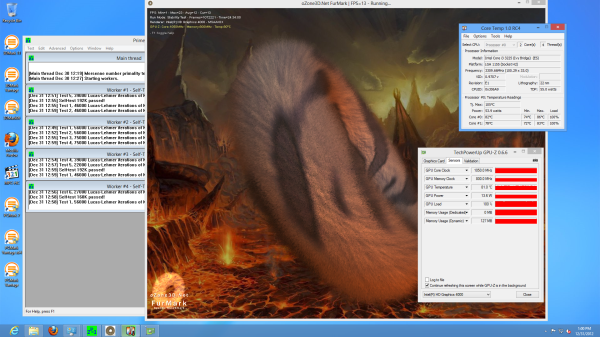
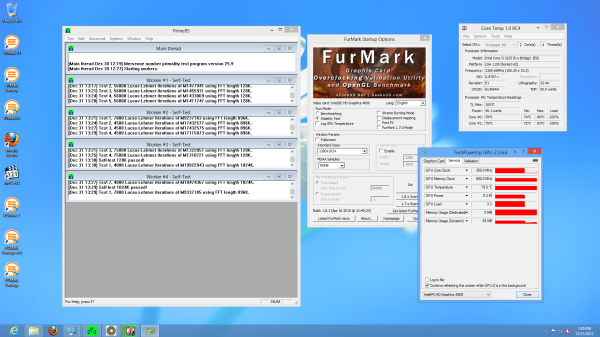
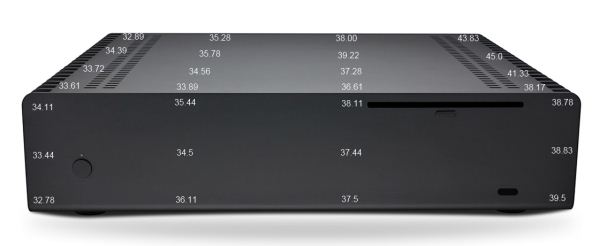
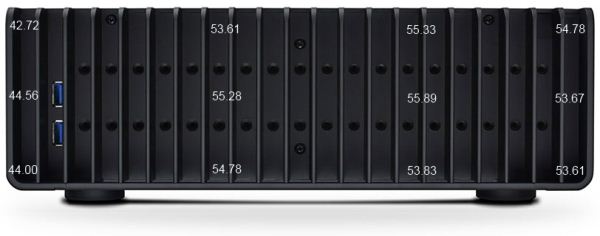
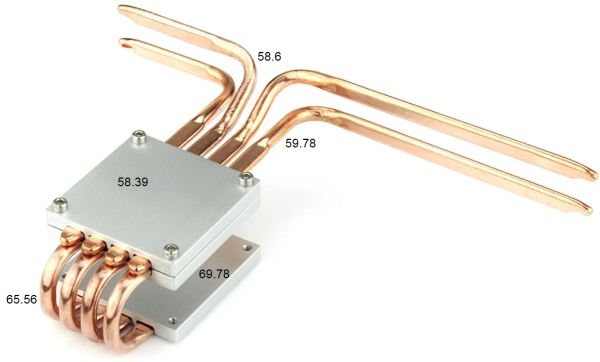








138 Comments
View All Comments
lexluthermiester - Monday, January 21, 2013 - link
I've run many tests doing the 8 VS 7 comparisons. Not only have you left out many of the comparing scores for 7, but your power usage numbers don't seem right.I have a Kill-A-Watt power usage adapter that plugs right into the wall, which measures total power running through it. Last night I ran tests using Netflix and 8 vs 7 on two different notebooks. The first is a Gateway P-7811FX[P9700 2.8 ghz C2D, GF 9800m GTS] and the second a Toshiba L655-S5150[i5-480m 2.66ghz, Intel HD]. The numbers for the Gateway were 67.3[8], 64.4[8 app] and 66.1[7]. The Toshiba's numbers were a bit better, 50.9[8], 47.1[8 app] and 50.8[7].
Now I could go one for days about game benchmarks and compatibility between 7 & 8. But real issue here is the your power numbers don't seem realistic. The Netflix app does have a small advantage, but nothing as dramatic as what you are showing. The difference between 8 VS 7 numbers are statistically insignificant. I ran battery tests as well. And those numbers are also statistically insignificant.
I'm not willing to accept your results as valid and quantifiable, unless you declare the testing equipment used and OS config setup.
lexluthermiester - Monday, January 21, 2013 - link
And before anyone states the obvious, yes the CPU's in each of those notebook were upgraded from their factory offerings. Both have 4GB of ram. The gateway has a WD 500gb 7200rpm HDD and the Toshiba has a Seagate 320GB 7200rpm. But remember these notebooks were not compared to each other, only themselves using one OS vs the other.ganeshts - Monday, January 21, 2013 - link
I stand by my numbers, and the tests were repeated multiple times to confirm this. Our configuration of the testbed itself is described in the first page of the review.For power measurement, we use the UFO Power Center from Visible Energy with a custom power measurement script described here:
http://www.anandtech.com/show/6413/visible-energy-...
I see that both the CPUs you used have old Intel HD Graphics (yes, Clarkdale and Arrandale were released when Intel HD Graphics wasn't that great). I think a lot of the advantage for the app version has to do with very good hardware decode acceleration (improved GPU and drivers).
Gigaplex - Monday, January 21, 2013 - link
You're claiming that minimal power savings with old architecture CPUs on notebooks (were the batteries plugged in?) as measured by you invalidates Ganesh's measurements on a desktop platform? Just... no.Galatian - Monday, January 21, 2013 - link
Does the Windows 8 GUI actually bring something on the table for a couch potato like myself? I just retired my old gaming rig which now serves as a HTPC and I kinda tasted blood with Steam in Big Picture mode. I'm planning on running a power efficient yet graphically powerful HTPC once Haswell (or perhaps a new AMD A10) is out, but I would really like for Windows 8 to be completely controllable by an XBox controller? Has Microsoft actually included support for that or was their only new feature touch support?lexluthermiester - Monday, January 21, 2013 - link
You can control Windows 7 with a 360 controller? Didn't know that. Is this something natively supported? Or is it a hack? Wait... I'm on the net I'll look it up... Very cool if it works though.Galatian - Monday, January 21, 2013 - link
Never said it did...not sure were you red this in my post??? I was just curious because for me the tile based start menu of Windows 8 would seem to be a perfect fit for a XBox controller support, hence my question. At least this would be one place in my house were Windows 8 might be useful. If not I'll jus stick to Windows 7Gigaplex - Monday, January 21, 2013 - link
If your TV is 720p rather than 1080p, then absolutely not. "Metro" apps don't run at 1280x720, an error message pops up telling you to change the screen resolution whenever you try to launch one.And no, sadly an Xbox controller doesn't work with "Metro".
coolhund - Tuesday, January 22, 2013 - link
LOL seriously?I mean I know that the minimum is 1024x768, but hell, everyone knows 720p is often used and thus I thought they were smart enough to allow that resolution, even if its not quite as high in the vertical. The stupidity of MS never ceases to amaze me...
powerarmour - Tuesday, January 22, 2013 - link
Unfortunately the Metro/Modern UI is neither remote friendly, nor controller friendly.Waste of time for a HTPC tbh.